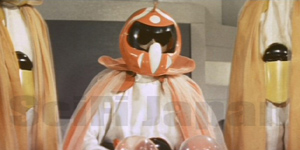Author: Aaron Cooper Source:British Film Institute Special Thanks to Keith Aiken and Robert St. John
 The British Film Institute follows up last October’s UK theatrical release of GODZILLA and THE MYSTERIANS with new DVDs of the two Toho classics. Photos courtesy of the British Film Institute. ©1954/1957 Toho Co., Ltd.
The British Film Institute follows up last October’s UK theatrical release of GODZILLA and THE MYSTERIANS with new DVDs of the two Toho classics. Photos courtesy of the British Film Institute. ©1954/1957 Toho Co., Ltd.The British Film Institute has asserted itself in the United Kingdom as a force to be reckoned with in terms of film preservation and appreciation, much like Criterion or the American Film Institute. Now with the BFI Video imprint, Japanese science fiction and fantasy fans can appreciate two classic films on DVD with lots of special edition bells and whistles. __________________________________________________________________________________________________________
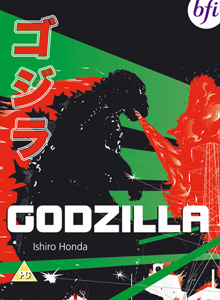 BFI’s GODZILLA DVD comes packaged is a special collector’s box. Photo courtesy of the British Film Institute. © 1954 Toho Co., Ltd.
BFI’s GODZILLA DVD comes packaged is a special collector’s box. Photo courtesy of the British Film Institute. © 1954 Toho Co., Ltd.GODZILLA
Hitting its golden years but still going strong Official Site: British Film Institute’s GODZILLA page The original version of the 1954 GODZILLA (Gojira) finally gets the DVD treatment it deserves for an English speaking audience from the British Film Institute on Region 2 PAL DVD. This forum will not be used for a story synopsis of this fine film. Chances are if you are visiting this site, you are a fan of such films and have already seen this one in some form. If not, then you really need to and you may as well make this edition the one as it just might possibly be the new standard by which to judge the film’s presentation. The British Film Institute acknowledges the import of this film in Japanese film history and has released this DVD accordingly in special edition box style packaging with nice artwork reprinting the UK re-release poster art by illustrator and fashion designer Phil Ashcroft. The film print used for the transfer is the cleanest seen to date. Presented in its correct aspect ratio of 1:33:1, the black, white and grey shades are sharp in this digital transfer with minimal scratches and imperfections, looking even better then the Rialto print many US theatergoers saw in 2004. The sound is in a crisp Japanese language Dolby Digital 2.0 mix.
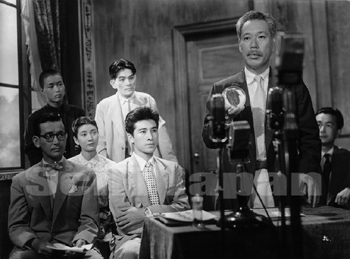 The main cast of GODZILLA looks on as Professor Kyohei Yamane (Takashi Shimura) presents his theory on the origins of the monster king. Photo courtesy of the British Film Institute. © 1954 Toho Co., Ltd.
The main cast of GODZILLA looks on as Professor Kyohei Yamane (Takashi Shimura) presents his theory on the origins of the monster king. Photo courtesy of the British Film Institute. © 1954 Toho Co., Ltd.Subtitles get the story across though they are not an exact translation and certain phrasing such as exclamations are left out, but signs and newspaper headlines are translated. It is difficult to criticize the subtitles, as many key sequences are properly handled and direct Japanese to English translations tend to be awkward, wordy, and detract from the point. The subtitles are handled respectable to the story matter and are removable if you want to enjoy the film in its original state. Though the subs may appear less detailed then on other prints such as the Rialto version that played US theaters, BFI did subtitle sequences such as the choir singing “O Peace, O Light, Return” which usually get left out. First up is an audio commentary by Steve Ryfle, author of Japan’s Favorite Mon-Star, the Unauthorized Biography of Godzilla; Ed Godziszewski of Japanese Giants and The Illustrated Encyclopedia of Godzilla fame; and Keith Aiken, artist of Godzilla for Dark Horse Comics and animator of GODZILLA: THE SERIES as well as organizer of several Japanese fantasy film festivals for the American Cinematheque. These guys know their stuff, with an engaging set of production notes, anecdotes and trivia regarding all aspects of this film. Even the most read-up watcher of this film will likely find something new to learn. Once in a great while the commentary sounds scripted, but for the majority of the 93 minute runtime it stays lively and is never boring. The guys keep talking and stay on topic as opposed to some commentaries.
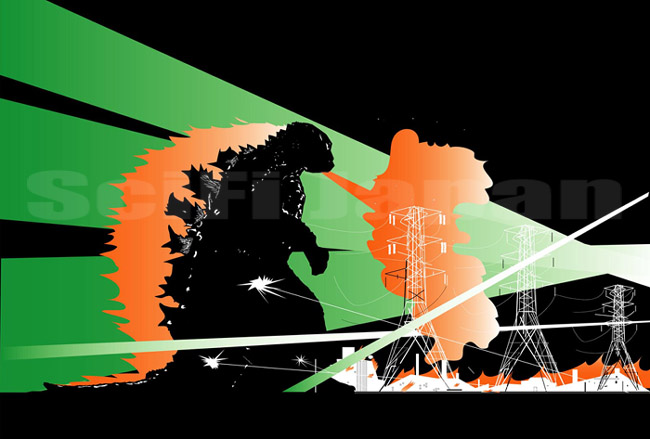 The never-before-seen preliminary version of Phil Ashcroft`s poster art for the UK release of GODZILLA. Photo courtesy of the British Film Institute. ©1954 Toho Co., Ltd.
The never-before-seen preliminary version of Phil Ashcroft`s poster art for the UK release of GODZILLA. Photo courtesy of the British Film Institute. ©1954 Toho Co., Ltd.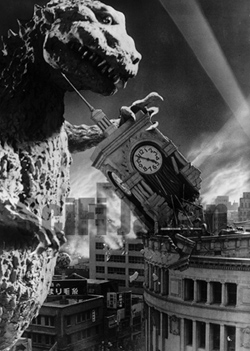 Godzilla tears down Tokyo in a cyclonic cavalcade of dynamic violence. Photo courtesy of the British Film Institute. ©1954 Toho Co., Ltd.
Godzilla tears down Tokyo in a cyclonic cavalcade of dynamic violence. Photo courtesy of the British Film Institute. ©1954 Toho Co., Ltd.There are three featurettes included, all of them only about 10 minutes apiece. The first entitled THE JAPANESE FISHERMEN (Eien Naru Heiwa) is a 1954 Japanese newsreel documentary covering the Bikini atoll nuclear tests and their effect on the Japanese, most notably the crew of the Lucky Dragon which are featured prominently here and were the genesis of the storyline for Godzilla. The feature has been given English narration for exhibition in the UK. The inclusion of this haunting and foreboding piece is brilliant on BFI’s part and lends historical understanding of the film’s origins. The next two mini-documentaries feature Ed Godziszewski, who wrote the scripts for each and supplied narration as well as stills from his private collection. The first, entitled “Designing Godzilla”, goes into the how and why suitmation was developed for this film and its impact in Japanese special effects work. Accompanied by a wide array of behind-the-scenes stills, the piece is informative and amazing in understanding just how difficult the process is and not at all the easy ‘man in rubber suit’ idea some critics would have us believe. “Story Evolution” is a meaty look at the script treatment for Godzilla and what was changed by shooting and subsequent editing. Some of the changes are quite fascinating, and this feature is enhanced with even more stills and storyboards of the changed or cut scenes. This fantastic extra is also presented by Ed Godziszewski and is the closest thing to deleted scenes we may ever see for this film. As if the featurettes didn’t already offer a visual feast of rare photos and production material, the Gallery section offers even more. Separated into categories of “Posters”, “Storyboards” and “Stills/Sketches”, the galleries offer a lot to look at in an easy to navigate style. Both the original Japanese trailer is included as well as the American trailer for GODZILLA, KING OF THE MONSTERS, though BFI’s description is a little misleading as it’s actually the Japanese trailer for Toho’s 1957 release of that version of the film under the title MONSTER KING GODZILLA (Kaiju O Gojira).
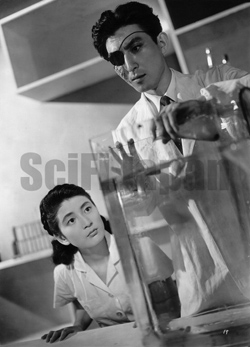 Dr. Daisuke Serizawa (Akihiko Hirata) reveals a terrible secret to his fiancé Emiko Yamane (Momoko Kochi) in this publicity photo from GODZILLA. Photo courtesy of the British Film Institute. ©1954 Toho Co., Ltd.
Dr. Daisuke Serizawa (Akihiko Hirata) reveals a terrible secret to his fiancé Emiko Yamane (Momoko Kochi) in this publicity photo from GODZILLA. Photo courtesy of the British Film Institute. ©1954 Toho Co., Ltd.BFI’s GODZILLA DVD also contains a decent size booklet with liner notes by British film historian Ian Buruma, well-known there for his commentaries on Japanese culture and film, as well as even more stills and photos not featured on the DVD itself. The booklet also contains brief yet respectable biographies for producer Tomiyuki Tanaka, director Ishiro Honda, special effects director Eiji Tsuburaya, and composer Akira Ifukube. The Gallery section also gives credit to the production designs of Yasuyuki Inoue, who provided several pieces from his private collection. Its due diligence on BFI’s part to acknowledge many of the talents that went into the creation of this ground-breaking film and those that assisted in making sure this was done should be commended. Keep in mind, you must have the capacity to play alternate Region DVDs and convert PAL on your system to properly enjoy the BFI release of GODZILLA. Those that do will find that between the commentary, the features and the wealth of extra information, this can be considered the most comprehensive and beautiful look at the film to date, and it gets the highest recommendation!
__________________________________________________________________________________________________________
 Cover art for the UK DVD of THE MYSTERIANS. Photo courtesy of the British Film Institute. © 1957 Toho Co., Ltd.
Cover art for the UK DVD of THE MYSTERIANS. Photo courtesy of the British Film Institute. © 1957 Toho Co., Ltd.THE MYSTERIANS
Alien Invasion of Region 2 Misses Mark in US When alien invaders in colored capes and helmeted voice translators come to Earth looking for a spot of land and a few women to procreate with, it doesn’t sit well with the citizens of Japan. It comes to arms when they realize they keep getting attacked by the invader’s giant burrowing robot and forceful attitude! Thus, the story in a nutshell for THE MYSTERIANS (Chikyu Boeigun, 1957), another first for Toho Studios that the British Film Institute acknowledges with a decent DVD release. THE MYSTERIANS was Toho’s first widescreen color science fiction film in their fantastic Tohoscope process that began a foray into a whole new genre. They had dabbled with science fantasy in GODZILLA (Gojira, 1954) and RODAN (Sora no Daikaiju Radon, 1956), now they were set to launch an onslaught of such films over the following two decades. The film is slightly weaker in some aspects then subsequent films such as BATTLE IN OUTER SPACE (Uchu Daisenso, 1959), GORATH (Yosei Gorasu, 1961) or the giant monster boom of the 1960’s in which the Toho formula becomes more finely honed; yet all the elements of what makes Toho films a notch above B-movie fare are presented here.
 Kenji Sahara shows MYSTERIANS promotional art to his costars Yumi Shirakawa, Momoki Kochi, and Akihiko Hirata. Photo courtesy of the British Film Institute. © 1957 Toho Co., Ltd.
Kenji Sahara shows MYSTERIANS promotional art to his costars Yumi Shirakawa, Momoki Kochi, and Akihiko Hirata. Photo courtesy of the British Film Institute. © 1957 Toho Co., Ltd.The print quality seems to be the exact same transfer as other releases of this film, blemishes and all which is especially noticeable towards the end of the film. The overall transfer is fine is in its correct aspect ratio, and is 16X9 anamorphic widescreen. Sound mix is in Japanese language Dolby Digital 2.0. Subtitles are removable. Like the BFI release of GODZILLA, subtitles here are not an exact translation, but still respectable and convey the point of the material. Extras include the original trailer that has been subtitled plus a gallery featuring publicity stills, lobby cards, posters, storyboards, and original production designs by Yasuyuki Inoue and Shigeru Komatsuzaki. A very nice booklet is included which contains liner notes by Kim Newman, a well-known and respected British fiction writer and critic of the horror and monster genre. Also included is a synopsis of the film and critique from The Encyclopedia of Science Fiction Movies by Phil Hardy, and more stills and production designs not featured on the DVD. Also included are brief but respectable biographies of producer Tomiyuki Tanaka, director Ishiro Honda, composer Akira Ifukube and designer Shigeru Komatsuzaki. Most of these biographies, with the exception of Komatsuzaki’s are available in the BFI GODZILLA DVD booklet, though oddly enough the biography for special effects director Eiji Tsuburaya that is included there is not contained in THE MYSTERIANS booklet.
You must be able to play alternate region DVDs and convert PAL on your system in order to properly enjoy BFI’s release of THE MYSTERIANS. This is where questions start to arise regarding the need for this disc for Region 1 patrons that have the Media Blasters release available to them. On that release, besides the Japanese language track with English subtitles, several alternate audio tracks are available including an English dub, a Spanish dub and a commentary track by Koichi Kawakita and Shinji Higuchi that also has been subtitled. The BFI version offers none of these. The extras on the Media Blasters version are a bit more comprehensive, though they are presented in slide show fashion while BFI allows for more self navigation. To date though, the Japanese Region 2 DVD has even more extras above and beyond the Media Blasters and BFI disc, though there is no translation for the English viewer. Media Blasters DVD can be played more readily on unconverted DVD players. Since the prints are nearly identical on all releases, it’s too bad the BFI release doesn’t offer more to coax US buyers into buying another edition, especially since the BFI GODZILLA DVD is such a comprehensive collection. On the other hand UK buyers have a fine release offered to them, which is really the point of the DVD. The cover art is very appealing and presents the film in a bit more serious vein, looking more like a Criterion presentation rather than a “Midnite Movies” approach. Though it is lacking in extras found in other releases, the print transfer, sound, subtitles and overall package design are more then adequate and this is a recommended release.


